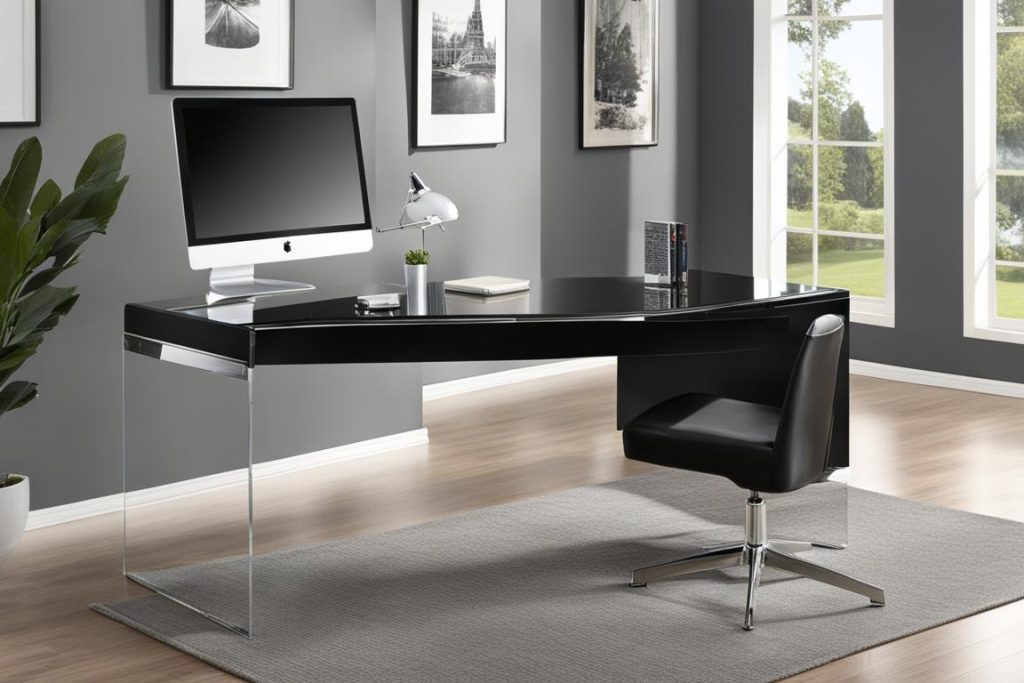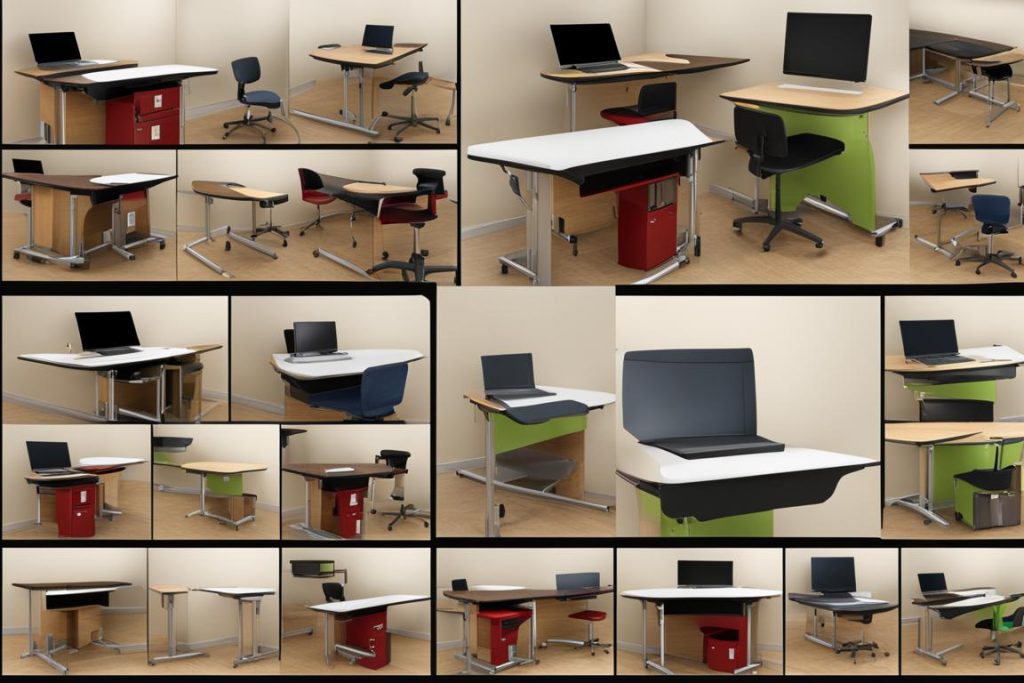Creating an ergonomic desk setup can make a world of difference in your work environment. By prioritizing your comfort and well-being, you can enhance your workspace, increase productivity, and protect your health. With a few key adjustments, you’ll transform your desk into a haven of productivity and efficiency.
- An ergonomic desk setup improves productivity, comfort, and overall well-being.
- Consider incorporating natural light, desk lamps, and indoor plants to optimize your mood and focus.
- Find the right temperature range for optimal work performance.
- Manage distractions by using noise-canceling headphones or ambient noise.
- Choose an ergonomic chair with lumbar support and maintain proper posture.
Improve Your Mood and Focus with Proper Lighting
Proper lighting can significantly impact your mood and concentration levels while working. Creating a workspace that prioritizes good lighting can help enhance your productivity and overall well-being.
Exposure to natural light has been shown to positively affect mood and increase alertness. If possible, position your desk near a window to take advantage of natural light throughout the day. If natural light is limited, consider using a desk lamp that simulates daylight. This can help reduce eye strain and improve your ability to focus on tasks.
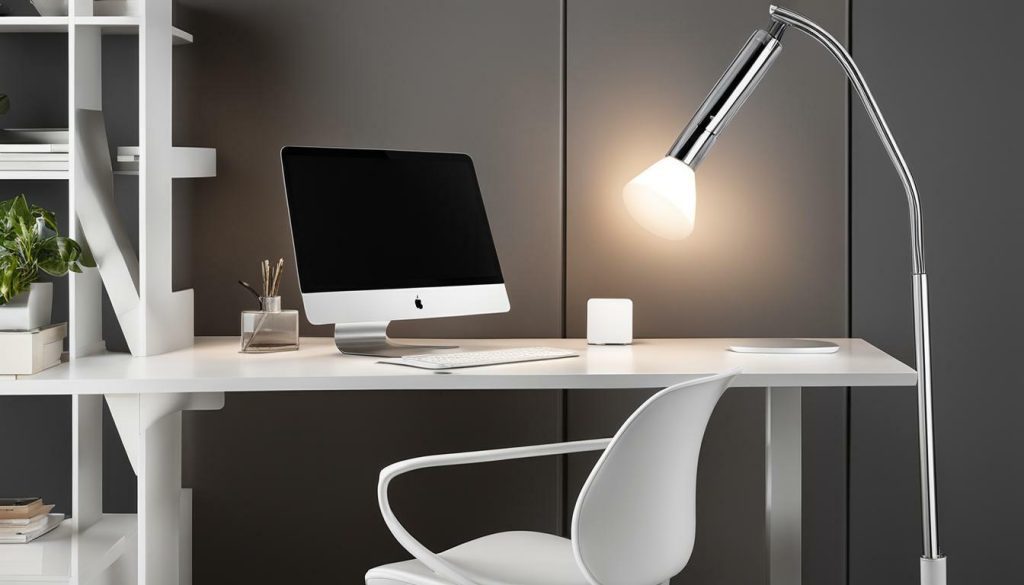

In addition to lighting, incorporating indoor plants into your workspace can have a positive impact on your mood and focus. Plants not only add a touch of greenery to your surroundings but also help purify the air, reducing fatigue and increasing your sense of well-being.
Creating a well-lit and vibrant workspace can help you feel energized and motivated throughout the day. So, take a moment to assess the lighting in your current setup and make any necessary adjustments to optimize your mood and concentration levels.
Find the Right Temperature for Optimal Productivity
Did you know that the temperature in your workspace can impact your productivity levels? Maintaining the right temperature is crucial for creating a comfortable and productive environment. Studies have shown that a temperature range between 71.6 to 75.2°F (22 to 24°C) is ideal for optimal productivity.
When the temperature is too hot or too cold, it can affect your concentration, cognitive function, and overall well-being. Being too warm can cause drowsiness and decrease alertness, while being too cold can lead to discomfort and distractibility.
It’s important to find a comfortable setting that suits your preferences. Consider factors such as your clothing, the weather outside, and the equipment you use that may generate heat or contribute to a cooler environment. Experiment with different temperature settings to find what works best for you.
| Temperature Range (°F) | Temperature Range (°C) |
|---|---|
| 71.6-75.2 | 22-24 |
Remember, everyone’s ideal temperature may vary slightly. What matters most is finding a temperature that allows you to focus, be comfortable, and stay productive throughout your workday.


Creating a workspace with the right temperature is just one of the many factors that contribute to an ergonomic and productive environment. By optimizing the temperature, you can enhance your focus, concentration, and overall performance.
Minimize Distractions with Noise Management Techniques
Distractions can hinder your work progress, but there are strategies to minimize their impact. Noise, in particular, can be a major issue when trying to focus. Fortunately, there are ways you can manage and reduce noise in your workspace to create a more conducive environment for productivity.
One effective solution is wearing noise-canceling headphones. These headphones use advanced technology to block out external sounds, allowing you to focus on your tasks without being disturbed by background noise. Whether you’re working in a busy office or a noisy environment, noise-canceling headphones can help create a quiet oasis for your concentration.
“Noise-canceling headphones use advanced technology to block out external sounds, allowing you to focus on your tasks without being disturbed by background noise.”
Another approach is to incorporate ambient noise into your workspace. While it may seem counterintuitive, certain types of ambient noise, such as gentle music or nature sounds, can actually help mask external distractions and improve focus. Consider using ambient noise apps or websites that provide a variety of soothing sounds to create a calming atmosphere that enhances your ability to concentrate.
To summarize, noise can disrupt your workflow and hinder productivity, but there are effective ways to minimize its impact. Whether you choose to use noise-canceling headphones or incorporate ambient noise, finding the right technique for your workspace can create a more tranquil and focused environment, allowing you to work more efficiently.
| Noise Management Techniques | Benefits |
|---|---|
| Noise-canceling headphones | – Blocks out external noise – Enhances focus and concentration – Creates a quiet working environment |
| Ambient noise | – Masks external distractions – Improves focus – Provides a calming atmosphere |


- Try using a white noise machine or app to create a consistent background noise that can drown out distractions.
- If your workspace is prone to loud noises from outside, consider using soundproofing materials or seals to minimize the impact.
- Communicate with your colleagues or family members about the importance of maintaining a quieter environment during your work hours.
Support Your Posture with the Right Chair
Your chair plays a significant role in supporting your posture during long hours of work. Choosing the right chair with proper lumbar support is essential to prevent discomfort and promote a healthy workspace. When sitting, make sure your knees are at or slightly below hip level to maintain optimal posture.
In addition to lumbar support, consider other features that contribute to your overall comfort. Look for a chair with adjustable height and armrests to ensure proper alignment with your desk and keyboard. The seat should be cushioned and contoured to provide adequate support for your thighs. Investing in an ergonomic chair not only protects your posture but also reduces the risk of back pain and related injuries.
To help you visualize the key features of an ergonomic chair, refer to the table below:
| Feature | Description |
|---|---|
| Lumbar Support | Adjustable support for the lower back |
| Height Adjustment | Allows customization based on your desk and height |
| Armrests | Provides support for your arms and shoulders |
| Cushioned Seat | Comfortable padding for extended sitting |
| Thigh Support | Contoured seat design for proper thigh support |
Remember, the right chair can significantly impact your posture and overall well-being. Invest in a high-quality ergonomic chair to create a comfortable and supportive workspace.
With a chair that supports your posture, you can work more efficiently and reduce the risk of discomfort and injuries. Prioritize your well-being by choosing a chair that promotes proper posture and consider investing in additional ergonomic office equipment to further enhance your workspace.
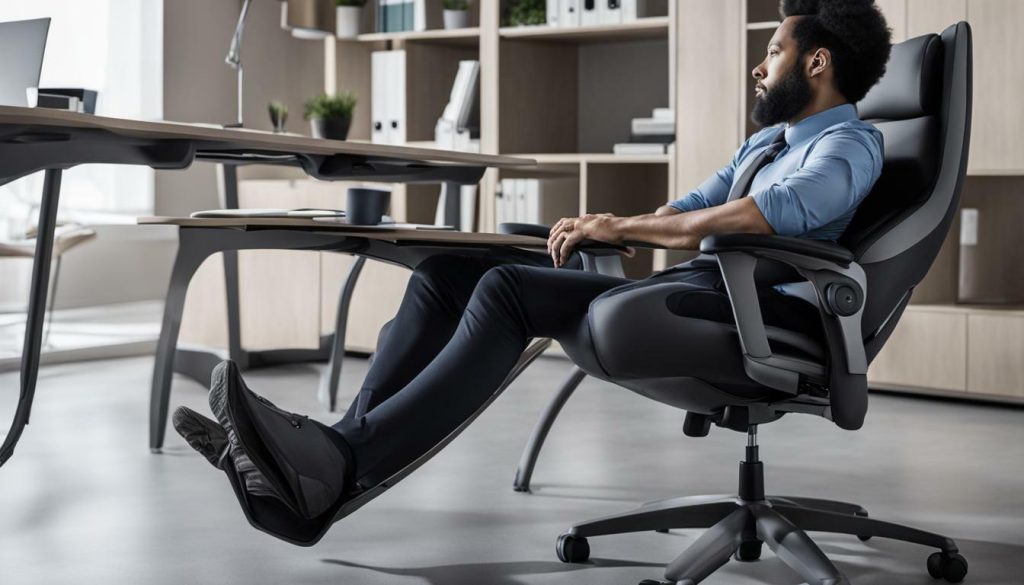

By incorporating ergonomic principles into your workspace, you can create a productive environment that keeps you comfortable and focused throughout the day. Remember to take regular breaks, adjust your desk and monitor heights, and incorporate movement into your routine to maintain optimal health and well-being.
Position Your Desk and Monitor for Optimal Ergonomics
Correct positioning of your desk and monitor can make a world of difference in preventing discomfort and strain. When it comes to your desk, ensure that it is at a height that allows your arms to rest comfortably at your sides, forming a 90-degree angle at the elbows. This will help alleviate tension in your shoulders and prevent wrist strain. Consider using an adjustable desk that allows you to switch between sitting and standing positions, promoting better circulation and reducing the risks associated with prolonged sitting.
As for your monitor, position it at eye level to maintain good posture and reduce strain on your neck and back. The top of the screen should be at or slightly below eye level, with a distance of about an arm’s length away. This will help prevent slouching and minimize eye strain. If necessary, use a monitor stand or adjust the height of your chair to achieve the ideal positioning.
| Desk Positioning | Monitor Positioning |
|---|---|
| Keep your desk at a height that allows your arms to rest comfortably at your sides, forming a 90-degree angle at the elbows. | Position your monitor at eye level, ensuring the top of the screen is at or slightly below eye level. |
| Consider using an adjustable desk to switch between sitting and standing positions for better circulation and reduced sedentarism. | Place your monitor at an arm’s length away to minimize eye strain. |
Remember to arrange the rest of your workspace accordingly to support your ergonomic setup. Keep frequently used items within arm’s reach to avoid unnecessary reaching or twisting motions. Use a document holder to prop up papers or reference materials, reducing strain on your neck. Additionally, consider investing in an ergonomic keyboard and mouse that promote a more natural hand and wrist position, minimizing the risk of repetitive strain injuries.
By prioritizing the correct positioning of your desk and monitor, you can create a workspace that supports good posture, reduces discomfort, and enhances your overall productivity.
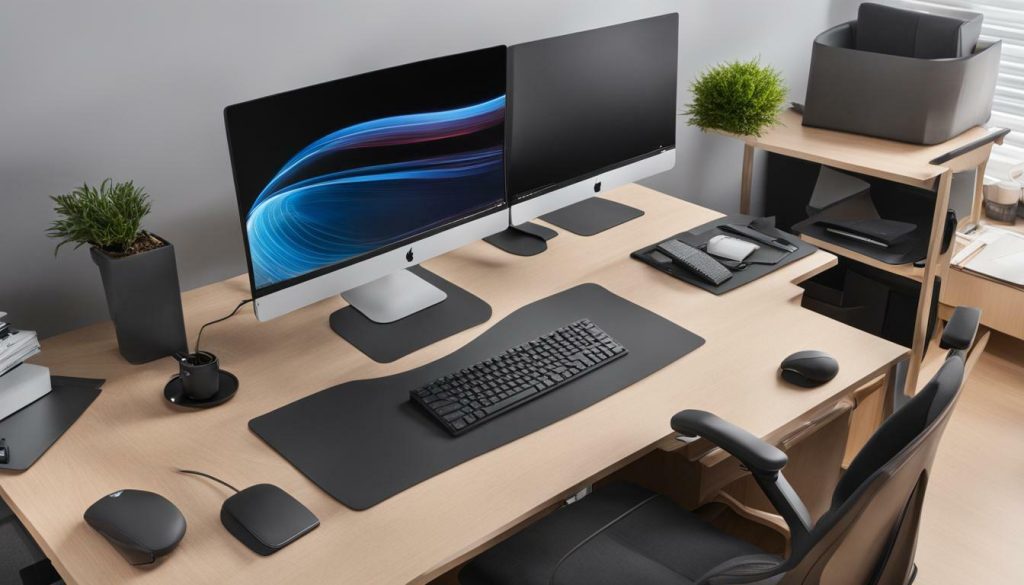

Sitting for long periods can negatively impact your health, but there are simple ways to incorporate movement into your workflow. Taking regular breaks and incorporating movement throughout your day can have a significant impact on your productivity, focus, and overall well-being.
One effective way to break up long periods of sitting is to set reminders for yourself to get up and move every hour. During these breaks, try stretching your legs, walking around, or doing some light exercises to get your blood flowing and muscles engaged. Not only will this help reduce the risk of sedentarism, but it can also help prevent muscle tightness and stiffness caused by prolonged sitting.
Another great way to incorporate movement into your work routine is to use a standing desk. Standing while working not only helps promote better posture, but it also allows for more movement and increased circulation. You can alternate between sitting and standing throughout the day to give your body a break from prolonged sitting.


| Movement Ideas | Suggested Duration |
|---|---|
| Take a short walk around the office or outside | 5-10 minutes |
| Do some stretching exercises | 5 minutes |
| Try desk exercises, such as leg raises or shoulder rolls | 3-5 minutes |
| Use a balance board or stability ball as a chair alternative | 20-30 minutes |
Remember, incorporating regular breaks and movement into your work routine not only helps improve physical health, but it also benefits your mental well-being. By giving yourself time to recharge and move throughout the day, you’ll find that your focus and productivity levels will increase, leading to greater overall satisfaction with your work.
Incorporating Ergonomic Office Equipment for Added Comfort
Investing in ergonomic office equipment can significantly improve your workspace and overall comfort. By incorporating these essential items, you can create a healthy and conducive work environment that supports your well-being and productivity.
Ergonomic Chair
A high-quality ergonomic chair is a key component of a healthy workspace. Look for a chair that offers adjustable features, including seat height, armrests, and lumbar support. Proper lumbar support helps maintain the natural curve of your lower back and prevents discomfort or pain. When sitting in your chair, ensure that your knees are at or slightly below hip level for optimal posture.
Desk Accessories
Enhance your workstation with ergonomic desk accessories. An adjustable monitor stand allows you to position your screen at eye level, reducing strain on your neck and preventing eye fatigue. A keyboard tray or ergonomic keyboard can help maintain a neutral wrist position, reducing the risk of repetitive strain injuries. Consider using a wrist rest to provide additional support and comfort while typing.
Standing Desk
A standing desk offers the flexibility to switch between sitting and standing positions throughout the day. This promotes movement and helps reduce the risks associated with prolonged sitting. When using a standing desk, ensure that the height is set correctly, allowing your elbows to be at a 90-degree angle when typing. Use an anti-fatigue mat to provide cushioning and support while standing.
Remember to adjust your workspace to suit your individual needs and preferences. Experimentation and customization are key to achieving an ergonomic setup that works best for you. Regularly reassess your equipment and make necessary adjustments to maintain a healthy and productive workspace.
| Benefits of Ergonomic Office Equipment |
|---|
| Improved posture and reduced risk of musculoskeletal disorders |
| Enhanced comfort and reduced discomfort or pain |
| Increased productivity and focus |
| Prevention of repetitive strain injuries |
| Support for overall health and well-being |
Investing in ergonomic office equipment is an investment in your long-term health and productivity. By prioritizing comfort and using the right tools, you can create a healthy and efficient workspace that allows you to perform at your best.
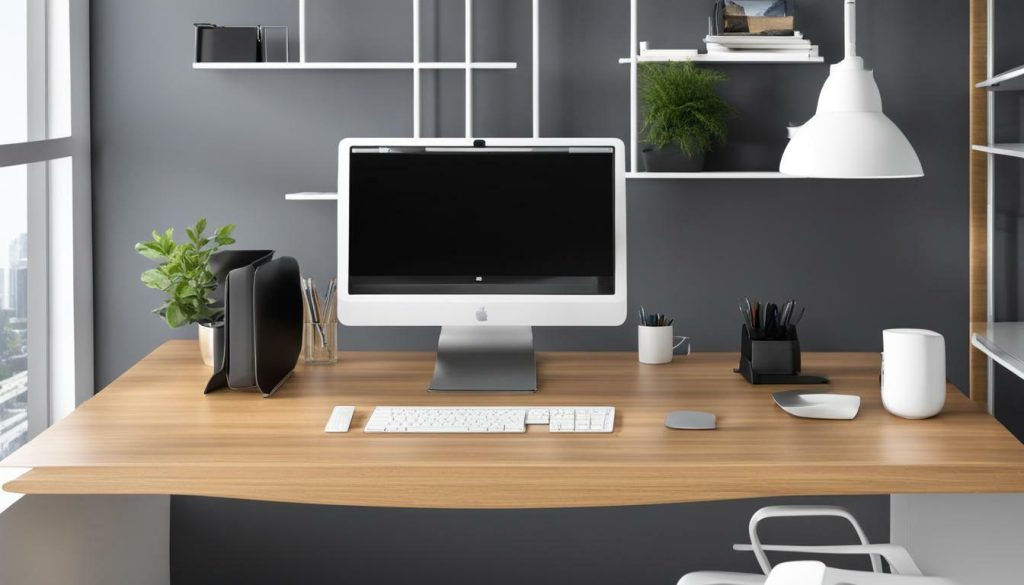

An adjustable desk allows you to customize your workspace to suit your needs and preferences. With the ability to switch between sitting and standing positions, you can maintain better posture and reduce the risks associated with prolonged sitting. By incorporating an ergonomic workstation, you can take control of your comfort and productivity.
Adjustable desks come in various designs and sizes, ensuring there is an option to fit any workspace. Whether you have a small home office or a spacious corporate setting, you can find an adjustable desk that meets your requirements. Some models even come with built-in storage solutions, allowing you to keep your workspace tidy and organized.
Not only does an adjustable desk provide physical benefits, but it also has a positive impact on your mental well-being. By alternating between sitting and standing, you can alleviate muscle tension and fatigue, keeping you more focused and energized throughout the day. It promotes better blood circulation and can even boost your productivity levels.
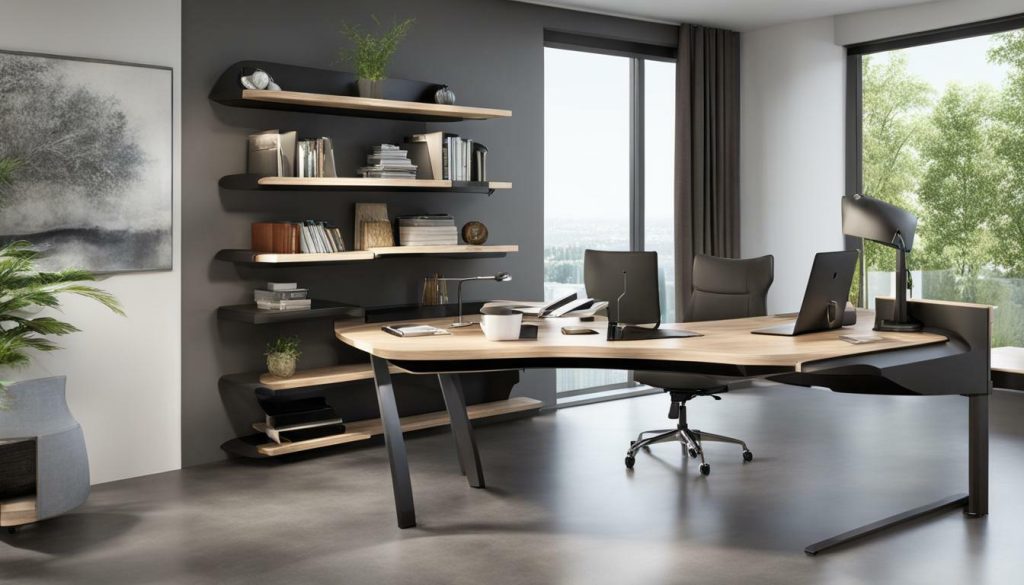

| Benefits of an Adjustable Desk |
|---|
| Customized height settings |
| Improved posture |
| Reduced back and neck pain |
| Increased energy levels |
| Enhanced focus and productivity |
Investing in an adjustable desk is a wise decision for anyone looking to create a comfortable and efficient workspace. It allows you to adapt your working environment to your specific needs, enhancing both your physical and mental well-being. So why settle for a static desk when you can have the flexibility and versatility of an adjustable one?
Enhance Typing Experience with an Ergonomic Keyboard
Typing for extended periods can strain your hands and wrists, but an ergonomic keyboard can offer a more comfortable experience. Designed with your comfort in mind, an ergonomic keyboard is specifically crafted to reduce the strain on your hands and wrists, allowing you to type for longer periods without discomfort.
One of the key features of an ergonomic keyboard is its split design. This unique layout helps to align your wrists and hands in a more natural position, reducing the risk of repetitive strain injuries such as carpal tunnel syndrome. By keeping your hands at a comfortable angle, an ergonomic keyboard promotes a more relaxed and ergonomic typing posture.
Apart from the split design, ergonomic keyboards often come equipped with adjustable height and tilt options. This allows you to customize the keyboard to your preferred typing position, further enhancing your comfort. By ensuring that your wrists have proper support and are not strained while typing, an ergonomic keyboard can greatly alleviate any discomfort or pain associated with prolonged typing.
Additionally, many ergonomic keyboards feature a cushioned palm rest. This soft padding provides support for your wrists, reducing the pressure on the sensitive nerves and tendons in this area. By minimizing the stress on your wrists, an ergonomic keyboard can contribute to a more relaxed and enjoyable typing experience.
| Benefits of an Ergonomic Keyboard | Features |
|---|---|
| Reduces strain on hands and wrists | Split design |
| Promotes a natural typing posture | Adjustable height and tilt options |
| Alleviates discomfort and pain | Cushioned palm rest |
| Enhances typing speed and accuracy | Ergonomic key layout |
Investing in an ergonomic keyboard is a worthwhile decision for anyone who spends a significant amount of time typing. Not only does it provide enhanced comfort, but it can also improve your typing speed and accuracy by allowing for a more natural and efficient hand movement. With the right ergonomic keyboard, you can ensure that your typing experience is not only productive but also comfortable and enjoyable.
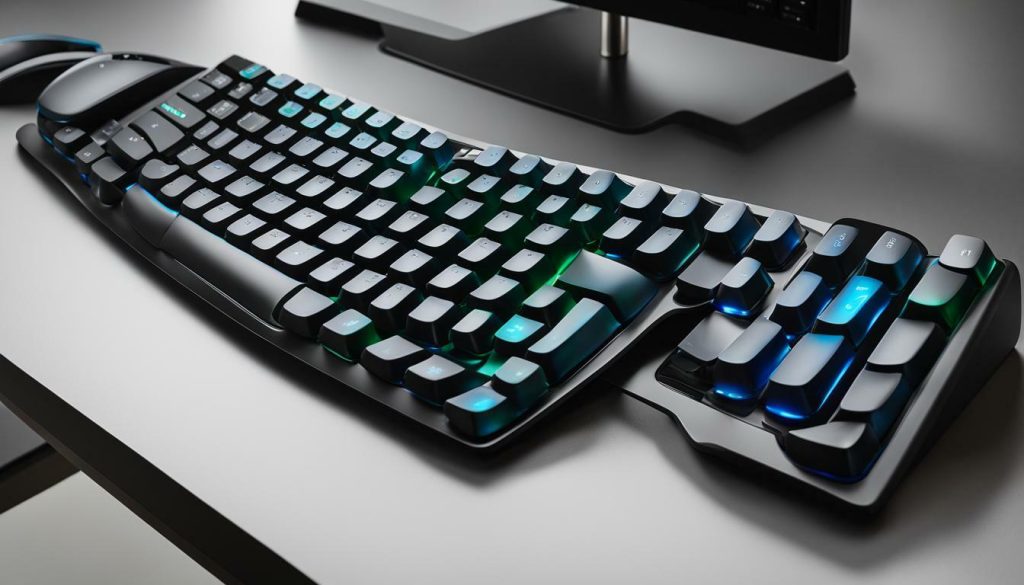

Remember, when it comes to your workspace, prioritizing comfort is key. By incorporating an ergonomic keyboard into your setup, you can reduce the strain on your hands and wrists, allowing for a more comfortable and enjoyable typing experience. So why not make the switch today and reap the benefits of an ergonomic keyboard?
Conclusion
An ergonomic desk setup is the key to unlocking a more comfortable and productive work environment. By incorporating the right elements into your workspace, you can experience a multitude of benefits for your overall well-being.
Proper lighting is essential for enhancing mood and focus. Aim to have exposure to natural light or invest in a desk lamp that simulates daylight to create an uplifting atmosphere. Adding indoor plants can also help purify the air and prevent fatigue, allowing you to stay alert and focused throughout the day.
Temperature control is another vital factor in optimizing productivity. Finding a comfortable setting between 71.6 to 75.2°F (22 to 24°C) can help you maintain focus and prevent distractions caused by extreme temperatures.
Noise can be a major hindrance to concentration. Consider wearing noise-canceling headphones or using ambient noise to create a more serene working environment that minimizes distractions and maximizes productivity.
The chair you choose is crucial for maintaining proper posture and preventing discomfort. Look for a chair that provides adequate lumbar support and allows you to sit with your knees at or slightly below hip level. This will help reduce strain on your back and ensure long-term comfort.
Positioning your desk and monitor at the appropriate heights is essential for maintaining good posture and preventing strain on your neck and back. Ensuring that your workstation is ergonomically designed will enhance comfort and reduce the risk of musculoskeletal issues.
Remember to take regular breaks and incorporate movement into your daily routine. Staying active throughout the day can improve your overall health, boost productivity, and prevent the negative effects of sedentarism.
Lastly, consider incorporating ergonomic office equipment, such as an adjustable desk and an ergonomic keyboard, for added comfort and versatility. These tools can further enhance your workspace and contribute to a healthier work environment.
Unlock Your Potential
An ergonomic desk setup is not just about having a visually appealing workspace; it’s about creating an environment where you can thrive. By implementing these ergonomic principles, you can experience improved productivity, enhanced well-being, and a greater sense of comfort as you tackle your daily tasks. Prioritize your health and make your workspace work for you.
FAQ
Q: What are the key elements to consider for an ergonomic desk setup?
A: The key elements to consider for an ergonomic desk setup include lighting, temperature, noise management, chair support, desk and monitor positioning, taking breaks, and incorporating movement.
Q: How can proper lighting improve mood and focus?
A: Proper lighting, such as exposure to natural light or using a desk lamp that simulates daylight, can improve mood and focus by creating a more positive and energizing environment.
Q: Why is finding the right temperature important for productivity?
A: Maintaining a comfortable temperature between 71.6 to 75.2°F (22 to 24°C) can enhance productivity by ensuring a pleasant and distraction-free working environment.
Q: How can I minimize distractions in my workspace?
A: To minimize distractions, you can wear noise-canceling headphones or use ambient noise to create a more focused atmosphere and block out unwanted sounds.
Q: What should I look for in an ergonomic chair?
A: Look for an ergonomic chair that provides lumbar support and allows you to sit with your knees at or slightly below hip level, ensuring proper posture and comfort.
Q: How should I position my desk and monitor for optimal ergonomics?
A: Position your desk at a height that allows your arms to rest comfortably on the surface, and adjust your monitor so that the top is at or slightly below eye level to prevent strain on your neck and back.
Q: Why is it important to take breaks and incorporate movement?
A: Taking regular breaks and incorporating movement into your routine helps prevent sedentarism, improves blood circulation, and reduces the risk of musculoskeletal issues associated with prolonged sitting.
Q: What other ergonomic office equipment can I incorporate for added comfort?
A: There are various ergonomic office equipment options available, such as an ergonomic keyboard, mouse, and monitor stand, that can further enhance your comfort and promote a healthy workspace.
Q: What are the benefits of using an adjustable desk?
A: An adjustable desk allows you to switch between sitting and standing positions, promoting better posture, reducing back pain, and increasing energy levels throughout the day.
Q: How can an ergonomic keyboard improve my typing experience?
A: An ergonomic keyboard is designed to support a more natural hand and wrist position, reducing strain and discomfort during typing, ultimately improving both comfort and productivity.

